Pear variety Chizhovskaya
Chizhovskaya is a mid-ripening pear variety with fruits of a late summer ripening period. Bred at the Moscow Agricultural Academy. K.A. Timiryazeva through hybridization of 2 varieties - Olga x Forest beauty... The work on creating a new variety was carried out by Russian breeders S.T. Chizhov and S.P. Potapov. In 1993, the variety was entered into the State Register (Central, Middle Volga, North-West regions). This pear is most widespread in the Moscow, Vladimir and Samara regions.
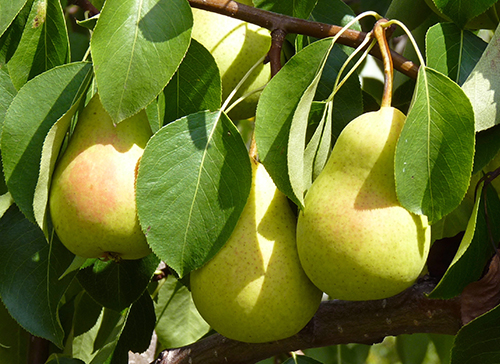
The trees are of medium size (height from 1.8 to 2.5 meters) and belong to the standard type. The crown is dense, medium-leafy, at a young age, narrow in shape, in the fruiting one - pyramidal or cone-shaped. The bark on the trunk is dark gray in color. Skeletal branches are gray in color and sloped vertically. The fruiting type is ringed.
Shoots of medium length and thickness, slightly curved, in cross section - rounded, reddish or dark brown in color. The internodes are lint-free, of medium length. Small lentils, few in number, are located at the surface level. The buds are dark brown in color, slightly deviated, conical in shape. The leaves are green in color, of medium size, elongated-oval in shape, often elongated, with a curvature along the central vein, with serrate-serrated edges. The leaf blade has an average thickness and a smooth, elastic surface; hairiness is absent on both sides. Petioles are of medium length. Stipules are lanceolate.
The flowers are medium in size, cupped in shape, the corolla is white, the petals are medium-close, with solid edges. The buds are white. Inflorescences are of the corymbose type, each with an average of 5 to 7 flowers.
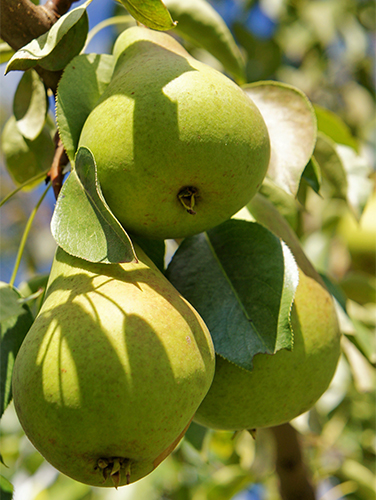
The fruits of the Chizhovskaya pear are medium in size (the weight of one fruit is about 110 - 140 grams), with a smooth surface. The shape of the fruit is typical pear-shaped or obovate. The skin is rather thin, dry, matte, smooth. The main color is yellow-green. The cover color is very weak (blurred pale pink blush on an insignificant part of the fruit) or is completely absent. Subcutaneous points of small size, expressed in an average degree. Rustiness is light, insignificant. The stalks are short in length and of medium thickness. The funnel is small, ribbed, narrow in shape. The saucer is small in size, narrow in shape, lumpy. Open cup. The sub-cup tube is medium in size. The axial cavity is medium. The heart is medium-sized, broadly oval, without granulations. Seeds of brown color, medium size, their average value in one fruit is 5 - 10 pieces.
The pulp is light yellow or almost white, semi-oily structure, melting, medium-term, with a subtle delicate aroma. In general, pears have a good sweet and sour refreshing taste (tasting score 4.1 - 4.2 points). Outwardly, the fruits are also very attractive. By chemical composition, the fruits contain: dry substances (16.5%), soluble substances (13.1%), the amount of sugars (9.1%), titratable acids (0.45%), P-active substances (166 mg / 100 g). According to its intended purpose, the variety is universal and suitable for homemade preparations (jam, compotes
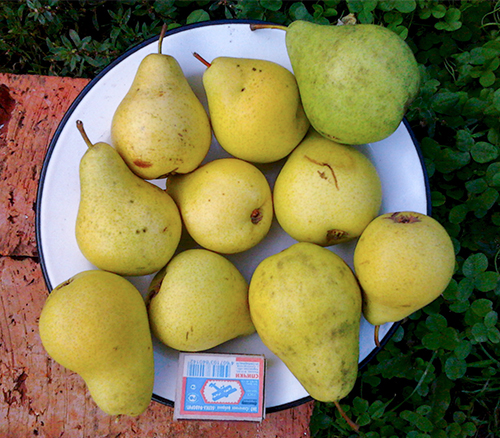
Pear Chizhovskaya belongs to mid-season, late-summer varieties. The shedding rate is low, the fruits are firmly held on the branches for a long time. When falling on a grassy litter, ripe pears are not damaged and can lie without losing their presentation for a week. It is also worth noting that ripe fruits fall quite heap (4 - 5 pieces side by side, as they grow on the branches), which greatly facilitates the harvesting process. At 0 ° C, pears can be stored for 2 to 4 months. Fruit transfer well. The marketability of fruits is high.
The variety is almost self-fertile. To obtain a higher yield, it is recommended to additionally plant pollinating trees in 3 - 4 meters, the best among which are the following varieties: Lada, Rogneda and Severyanka.
The early maturity of the Chizhovskaya pear is quite high, the trees enter the fruiting season 3-4 years after grafting. Fruiting is regular. The yield indicator reaches 50 kg of fruits per tree. Winter hardiness is high. Scab resistance is also quite high. It is worth noting the high resistance of the variety to extremely unfavorable external conditions and to most pathogens.
The obvious advantages of this pear are: high frost resistance, early maturity, presentation and good fruit taste.
The main disadvantage: with age, the fruits on the trees become smaller.
Slightly acidic soil is ideal for planting trees. Previously, it must be well fertilized with humus, lime and mineral fertilizers (superphosphate, potassium chloride). If the soil is acidic, lime must be added to the soil.
Due to the tendency of the crown to good branching, and the fruit to shrinkage, it is recommended to regularly rejuvenate the trees by pruning in early spring (before the vegetative period).
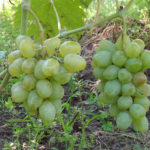
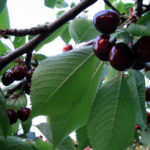
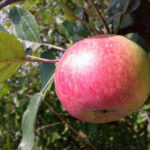
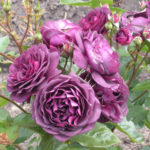
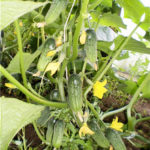




Our pear Chizhovskaya was planted in 2010, that is, it is now the sixth summer. We planted a seedling in the spring, and after the first winter it died from frost. But the stock and roots did not suffer, and only the upper branch of the scion froze. In the second summer, the dead seedling sprouted new shoots from the scion above the grafting site to the stock, and over the summer grew back to its previous size (another pear frozen nearby, but the scion died and new shoots of the branch from the stock, and since the scion was grafted into a wild pear, then new shoots became wild). After the second winter, the seedling froze again and died, but in the spring it again gave new shoots. For the third winter, over the spruce paws with which we usually wrap trees for the winter, we wrapped the trunk of a pear with a cloth. As the snow fell, they threw it around the trunk as high as possible. The seedling survived the third winter well, and already at 4 years old the tree bore its first fruits.
The fruits are juicy and tasty, but not very well stored if they are overripe in the sun. For pollination, a Lada pear tree was planted nearby, three meters away. In the spring, to drive away harmful organisms into the trunks, we sow phacelia, and perennial lupine was also planted. Planting phacelia and lupine enriches the soil around the roots and nourishes the pear roots with nutrients.
We have a Chizhovskaya pear for 7 years, during this time it has never bloomed. Planted in the spring, on the western side of the site. The tree winters well, a beautiful crown has formed, the trunk is powerful, although there are frosty (or maybe sunburn) burns on the bark in some places. Yes, here's another: our soils are sandy, poor, the layer of humus is only 40-50 cm, then there is sand. Isn't that the reason?
Also 7 years did not bloom. And he ran around with an ax and scolded him :)) In the fall (2015) he cut off all the branches by 1/3 part and ... the "infection" blossomed. Now I'm waiting for the full ripening of the fruits - about 10, probably. Beautiful, healthy - the eye rejoices.
I noticed, from my own experience, pruning has a very strong effect on the fruiting of pears. During the summer, I cut off new shoots into three to four leaves. The tree looked like a New Year tree, all in pears.
And we Chizhovskaya WAS like a New Year's tree. In the third year - 1 pear, in the 4th - 5 pieces, and then 30 pieces (6th year). The beauty! Very tasty! But the harvest of the 7th year did not wait! It blossomed, fruit set, then became burgundy. I suffered for a long time, turned black and ... no.
Last fall we bought Chizhovskaya again, we really liked it. And the old one is still alive, with new shoots. We hope for a miracle.
Our leaves turned black in the summer three years ago, we sprayed the tree with a solution of manganese, and the next spring, before flowering, after awakening the buds, we also sprayed it. Everything has passed, now we do this every year in the spring, planted a Chizhovskaya pear in 1998.
Irina. Yaroslavl Our pear is only two years old. It was difficult to get accustomed, we thought it would not endure the winter. But the winter was mild. Leaves appeared quickly in the spring, and everything was fine until mid-July, when the leaves began to take on a burgundy hue. Now our pear is all burgundy. What to do? How to treat the poor fellow? What is she missing?
Maybe my advice will help.
1) Pears love pruning, especially in summer. I live in the suburbs and cut as soon as the young growth reaches 40-50 cm. But! This can be done before August 1, otherwise new shoots will not get stronger by winter and may freeze out. We cut the shoots of this year, shortening the branch to 20 cm. By the end of summer, somewhere at the beginning of September, lateral shoots will form - this is a future harvest in a year.
2) Second tip. Along the perimeter of the trunk circle, every 40 cm with a metal pipe D = 4-5 cm, we make holes in the ground with a depth of 40-50 cm. We fill these holes with fertilizers, both organic and inorganic. Read the dates and names of fertilizing on the Internet.
3) Do not forget that whitewashing trees is a must in spring, summer and autumn. We extinguish the quicklime to the state of sour cream, add the same amount of acrylic white paint and dilute it in water for 1 liter of ready-made sour cream mixture 2 with the top of Art. spoons of copper sulfate. We whiten not only the trunk, but also the bases of the skeletal branches.
The harvest will not keep you waiting long. Good luck !!!
In 2011, she planted the Chizhovskaya pear grafted in the same spring. Vigilantly "dish" the crown, cutting off the central conductor annually, shortening the branches by 1/5 - ¼, bending them to a horizontal state and removing tops. In 2015, it bloomed for the first time, the pollinator was rotting pears, there were 7 large fruits. This year, in case of "non-flying" weather for bees - 12 fruits. By the way, the neighbors planted three pears of different varieties at the same time with me, one of them is also Chizhovskaya, but did not touch the crown. As a result, three-meter trees, on which this year there was only one fruit. Conclusion - with the tendency of the pear to build up a fusiform crown with a large number of vertical shoots (which, as you know, are unproductive), it is necessary to monitor the formation of the crown.
Our pear Chizhovskaya grows well in favorable places and on a trunk, in the lowlands it is recommended to grow it in stanza. I have been growing for 3 years already, like Lada. And besides freezing of unripe shoots 2 cm, there were no serious freezing. This year the tree bloomed early, I hope the frost did not harm.
Stlanz are not for me. Chizhovskaya has good winter hardiness - she has genes of the Ussuri pear in her genus.
Our Chizhovskaya is 20 years old. Bears abundantly, but some of the fruits do not ripen. The tree is already over seven meters high. Fruits ripen in mid-August, collect still green. When they lie down, the taste improves. The fruits are heavily crumbled during the winds. In a good summer, the taste is excellent, but not all fruits.
Strange! And on the Internet they write that the height of Chizhovskaya is 1.8-2.5 meters !!!
The pear was planted in 2016. This year (2017) it blossomed and produced 12 fruits. Delicious! But for some reason, some of the pears cracked. Maybe too much watered? We have a dwarf pear, bought in the nursery for a two-year-old.
Yes, pears and cherries crack from abundant and frequent watering, and if you feed them excessively with manure.
My pear Chizhovskaya is fifteen years old. The first five years she did not give fruit because of my mistake: she planted it very high and only when a twig with a thorn appeared on the rootstock, did she realize her mistake. Of course, I fixed it, but time was lost. The first fruits were small and small. Then there were years with cold and damp summers, and black bloom appeared on the leaves and fruits - there was no harvest, respectively. But, finally, we have coped with all the problems, and for 7-10 years now, the pear has been giving a stable harvest. Of course, sometimes more, sometimes less, depending on the year - the climate in the Ivanovo region is not very favorable for such plants. I like the taste of the fruit. I have not tried to store them, as we eat them immediately as they ripen.
What do you mean planted high? We also do not bear fruit and thorns have appeared. I can’t understand what’s wrong with her.
What are thorns?
If, during planting, the root collar is strongly exposed, so that the roots will be visible, that is, there is a risk that shoots will grow from the stock, the stock is usually wild. And thorns grow on it.
The seedling was planted in the spring, along with other pears. In the summer, the leaves and branches began to turn black and dry. Some pears died, but this variety survived. After winter, cracks formed on the trunk from the south side from the very bottom to the top. Smeared with clay mixed with copper sulfate. And also left two branches below the crack. After 3 - 4 years, the crack healed completely. The branches left behind grew and overtook the main fractured trunk.
Then he found out that the cause of the death of the seedlings was the so-called bacterial burn. And other varieties just turned out to be less immune to the disease. It was not possible to grow them without the use of pesticides against this disease.
The taste of the fruit in Chizhovskaya depends on the sunlight, in the sun the fruits are sweet, in the shade they are sour. Pears are stored a little, 1 - 2 weeks.
Bacterial burn is a scourge of recent years, but it can be treated quite easily with antibiotics.
We bought seedlings in nurseries (no disease was seen on the seedlings, since they are sprayed very often in nurseries), when planting in the garden plot, a bacterial burn appeared after 2 weeks, the edges of the leaves turned black, young shoots bent down and blackened on young shoots black smudges of liquid ... We treat with antibiotics: Gentamicin - 1 ampoule per 1 liter of water, Streptomycin 2 tablets per 1 liter of water, spray the entire tree including the trunk to the ground.
Favorite Chizhovskaya reminds me of Duchess very much - juicy, sweet, soft. It has been growing on our site for more than 10 years, the place is sunny, the land is fertile - I don't know any problems with it. I level the crown every year, otherwise it will overgrow with a stormy forest - and this will both disease and affect the fruits. We collect the harvest in buckets. Pears are poorly stored (they quickly lose their taste, become loose), it is better to collect them gradually, by hand, because when falling, they hit the branches and quickly deteriorate. Most of it, of course, is eaten, but there are always a couple of buckets for jam. I also really liked drying it - the children manage to eat everything before the New Year.
I subscribe to every word. I will add that the pear is self-fertile and does not need a pollinator. We use it for drying and compote. Suffers very much from wasps, gnaw the fruits clean
I love pears, but for many years I bought zoned seedlings of modern varieties in nurseries, planted them according to science, watered and processed them, but as soon as they began bearing fruit, they died.I was already desperate, but I came across a Chizhovskaya sapling. The pear is old, but excellent - in my opinion, it has no minuses, only pluses: it is not tall, bears fruit annually (provided that there is a pollinator nearby), does not get sick with any "pear diseases", does not freeze even in the most severe winters and tolerates wind well (the crop does not crumble), and most importantly, it does not "notice" groundwater, which did not allow other trees to take root in our area. The only thing that does not suit me is the keeping quality of the hearths - I would like them to lie longer, otherwise, with a large harvest, it is not realistic to eat them all and cannot be stored for a long time.
Hello. Maybe someone knows, please tell me. Chizhovskaya planted a 3-year-old sapling last year, this year she gave the first fruits, but they were so small, small, there were three pears. Why are they small? Because the tree is young? Although I am looking at the video, the man showed the fruits quite large, taken from a young tree. Maybe I did something wrong? Or will they be so tiny? 🤔
I think it's just that the pear is still young. Our first ones were also smaller. But it does not give very large fruits by the variety. Our largest pear was 180 g.
This year, Chizhovskaya is blooming, and there are no leaves at all or not opened. What is it? Pear 4th year. For the first time last year, there were fruits. Only three.
To all the casks of honey declared here, I will add my little fly in the ointment. Pear has been sitting in the country since the late 80s. The height of the tree is already eight meters. So it is inconvenient to spray. Modern plastic sprayers do not finish off to the top, and the old Soviet one did, but is already unusable, because it is rotten through and through. Hence the main trouble. On fruits that have not yet matured, black spots already appear. And they start to rot right on the tree. Wasps are also very fond of them. They eat up a significant part of the crop. Pears are not stored at all. Today I took a good fruit, and tomorrow it already starts to deteriorate. And the harvest is simply monstrous, but because of these shortcomings, a lot is lost. I manage to dry something in the bath. It turns out very tasty. Children eat better than candy. The site is close to groundwater (about 1 m). All apple trees died after about 20-25 years. A pear at least that. This is a big plus. This means that it can be planted in low areas with a close location of waters. The tree is not afraid of frosts at all. Even flowers suffer from spring frosts much less than flowers of apple trees. The tree is very fragile. Branches under the weight of the fruit break constantly, despite the props.
Since the late 80s? The variety was bred in 1993 ... 8 m - is this exactly about Chizhovskaya?
Winters well, tastes good, decent variety.
But in some years, the fruits lack juiciness and over the years they become smaller.
A young pear appeared on our site at a distance of 2 meters from the Chizhovskaya pear. The tree is already human-sized. Please tell me if there will be fruits on it without vaccination. No spikes on the trunk